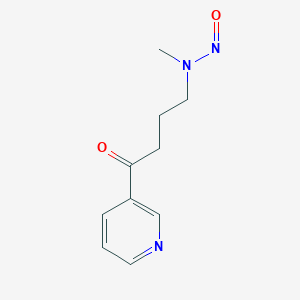| 1 |
Characterization of enzymes participating in carbonyl reduction of 4-methylnitrosamino-1-(3-pyridyl)-1-butanone (NNK) in human placenta. Chem Biol Interact. 2001 Jan 30;130-132(1-3):737-48.
|
| 2 |
Sex hormones reduce NNK detoxification through inhibition of short-chain dehydrogenases/reductases and aldo-keto reductases in?vitro. Chem Biol Interact. 2017 Oct 1;276:167-173. doi: 10.1016/j.cbi.2017.02.016. Epub 2017 Feb 28.
|
| 3 |
Gene expression profiles in HPV-immortalized human cervical cells treated with the nicotine-derived carcinogen 4-(methylnitrosamino)-1-(3-pyridyl)-1-butanone. Chem Biol Interact. 2009 Feb 12;177(3):173-80. doi: 10.1016/j.cbi.2008.10.051. Epub 2008 Nov 6.
|
| 4 |
Long-term exposure to extremely low-dose of nicotine and 4-(methylnitrosamino)-1-(3-pyridyl)-1-butanone (NNK) induce non-malignant breast epithelial cell transformation through activation of the a9-nicotinic acetylcholine receptor-mediated signaling pathway. Environ Toxicol. 2019 Jan;34(1):73-82. doi: 10.1002/tox.22659. Epub 2018 Sep 26.
|
| 5 |
Nicotinic receptors mediate tumorigenic action of tobacco-derived nitrosamines on immortalized oral epithelial cells. Cancer Biol Ther. 2006 May;5(5):511-7. doi: 10.4161/cbt.5.5.2601. Epub 2006 May 13.
|
| 6 |
Haem oxygenase-1 plays a central role in NNK-mediated lung carcinogenesis. Eur Respir J. 2008 Oct;32(4):911-23. doi: 10.1183/09031936.00064508. Epub 2008 May 28.
|
| 7 |
4-(Methylnitrosamino)-1-(3-pyridyl)-1-butanone, a component of tobacco smoke, modulates mediator release from human bronchial and alveolar epithelial cells. Clin Exp Immunol. 2005 Apr;140(1):46-53.
|
|
|
|
|
|
|



